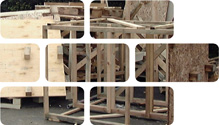
Wooden Packaging Wood 15 01 03
Wooden packaging crates, cradles and containers are made in various sizes and shapes depending on the specification required. They are commonly made from softwoods, dullage, shuttering plywood and waferboard although some will be tailor made and may be of good quality timbers. Wooden packaging is rarely treated or painted other than sprayed paint markings. Some may be contaminated from their former contents.
Usage & Probable Locations
Wooden packaging is used to transport and store goods and materials. They may be found in the store rooms of buildings being demolished or delivered to refurbishment sites. Spares and replacement parts for plant and equipment may be delivered to site in wooden packaging and are frequently non-returnable.
Personal Protective Equipment
PPE requirements indicated are for guidance purposes only. DRIDS has identified the PPE that is mandatory on all demolition projects and ones that may be required subject to site specific Risk Assessment & Method Statement (RAMS). Hover over the icon to determine the types of PPE required for the removal of this material.
Removal, Segregation & Storage
Depending on the quality and destination of the wooden packaging, will determine how it is segregated and stored. Wooden packaging in good condition and a usable size may have a reuse value, especially if there is a large number of similar size. An outlet for their reuse should be arranged before they are segregated and stored inside or covered with plastic or tarpaulin to keep them dry. They should also be stored away from plant movements to prevent breakage or splash damage. Wooden packaging destined for recycling or recovery should be segregated from other materials in a timber only skip. Wooden packaging destined for landfill can be placed in the mixed waste skip.
Tools
Fixtures, Fittings & Connections
Wooden packaging is commonly manufactured from unplanned timbers and timber sheets using nails, screws, nuts and bolts, staples, metal plate connectors, nail brackets or corrugated fasteners. Wooden containers and crates may also include hinges and hasps and staples for security. Some wooden packaging crates or containers may be painted or preserved in one form or another. Some may be fitted with polystyrene or foam packing materials or include polythene sheet, sawdust, foam chips or wood wool which may need removing before sending for recycling or recovery.
Health & Safety
Subject to task-specific Risk Assessment & Method Statement (RAMS). Use correct protective equipment for removing fixings, especially nails and screws. Wear gloves when handling unplaned wooden packaging, which may also have damaged edges or coated in preservatives. Gloves will prevent irritation, cuts and splinters. Wear eye protection when removing fixtures, fixings and connections with a crowbar, hammer, nailbar or chisels. Wear a face mask when removing sawdust.










